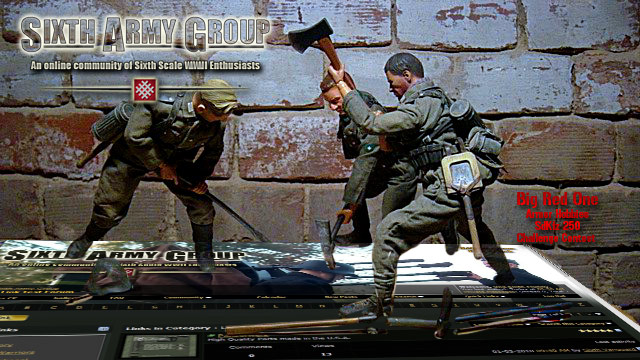Sixth Vanguard
Board Flunky, aka Site Admin
Obergefreiter Erhard Kurz, Panzer-Grenadier-Regiment ”Feldherrnhalle 1”, Hungary, late March 1945
The “Feldherrnhalle” units were combat formations which drew manpower from the SA, tracing their history back to the 1923 Beer Hall Putsch. The Feldherrnhalle (“Hall of Generals”) is the monument in Munich where the coup was crushed, and the units which bore the title were considered the elite of the SA. The original “Feldherrnhalle” regiment wasn’t a combat unit, but provided guard units for SA offices. The “Feldherrnhalle” units fought with distinction from 1940 to 1945 and were considered elite formations, yet they are almost forgotten.
In March 1938, men from the regiment were among the first units to march into Austria during the Anschluss. In September 1938, the “Feldherrnhalle” regiment was placed under the control of the Wehrmacht, and part of the regiment was used to form the 271.Infanterie-Regiment of the 93.Infanterie-Division. The 271st fought well in France in 1940, and went on to participate in Operation Barbarossa, fighting with distinction on the Leningrad front. In the summer of 1943, the regiment was sent to France, where it was rejoined by her sister regiment (120.IR) after being apart for five years. They were amalgamated into the new 60.Panzergrenadier-Division “Feldherrnhalle”, and returned to the Eastern Front in December, 1943, where it was involved in the fighting withdrawal in Byelorussia. It was transferred to the Narva bridgehead, where it saw heavy action until ordered south to Army Group Centre. The division was annihilated outside Minsk in late July during Operation Bagration. Members of the division who had been absent were ordered to reform in Germany during the fall of 1944, forming the Panzergrenadier-Division “Feldherrnhalle”. It was promptly sent to Hungary to help shore up the front, and contributed in halting the Soviet advance on Budapest. This just delayed the inevitable, and in February 1945, “Feldherrnhalle” was destroyed again together with other German units when Budapest fell. Among those to escape the pocket was a group of several hundred “Feldherrnhalle” men.
The surviving veterans formed the cadre for Panzer-Division “Feldherrnhalle 1”, and fresh SA recruits filled the ranks. The new division became part of Panzerkorps “Feldherrnhalle”. The corps was activated at the end of February, with most of the combat units being sent into action at the end of March 1945. The Panzerkorps executed a fighting withdrawal towards Vienna and then into southern Austria. Over the last months of the war, the corps saw heavy fighting and acquitted itself well. By the beginning of May 1945, the shattered remnants of the corps broke up and attempted to reach the American lines, where they surrendered on 9 May 1945. The majority of the survivors ended up in Soviet PoW camps.
My interpretation of a “Feldherrnhalle” Panzergrenadier is based on a combination of common German army uniform items and gear together with unit-specific insignia, intended to create the impression of one of those who was fortunate enough to be at home, recuperating from wounds sustained at Narva, thereby avoiding the catastrophe outside Minsk in 1944. His gear and uniform is a mix of new, old and re-issued stuff. A survivor of Budapest, Kurz is determined to do what he can to stop the Red Army steamroller. He’ll need all the luck he can get…
Figure: DML Erhard Kurz
The figure is unmodified, apart from being fitted with bendy hands.
Uniform: DML Soldat 004B
Camo trousers: DML Jupp Bauer
Sweater: DML
Gloves: DiD
Boots: DML
The uniform and associated items are slightly weathered with dark brown pastels, and in the case of the boots acrylics as well.
Medals: DML, DiD
Kurz carries the bronze Infantry Assault Badge, awarded back when his unit was motorized infantry. The black Wound Badge isn’t visible, but shows that he has sustained a couple of wounds serious enough to qualify for the award. The tank destruction badge is the tank from a DiD badge, painted and mounted on silver-grey trim.
Helmet: DiD
The DiD Waffen-SS helmet was repainted dark brown and custom decals were applied. Surviving “Feldherrnhalle” helmets are usually dark brown and with double decals. About ten genuine double decal combat helmets are preserved. The decals were varnished to give them a slight sheen. A custom chinstrap was fitted.
Insignia: DML, CVI, custom
The shoulderboards are standard DML items, customized with “embroidered” SA Kampfrunes printed in Panzergrenadier green. The collar tabs, national eagle and Obergefreiter chevrons are from CVI. The cuff title was printed on paper and clued to thin, white trim for increased durability. All custom insignia and decals were created from photos and scans, cleaned up with MS Paint, and printed on an inkjet printer.
Belt, Y-straps: DiD
The (p)leather was given a thin coat with diluted black acrylic paint and were slightly weathered.
G43 magazine pouch: DML
Ammo pouch: Newline Miniatures
The ammo pouch had a spanking new shiny black leather look, white seams and natural leather edges, all of which were fixed with very dark black-brown acrylic paint.
E-tool: DiD
E-tool carrier: custom
The wood and metal entrenching tool needed a carrier that looked late war. A typical carrier was made from “Press-stoff” cardboard-and-resin ersatz leather, but the plastic version from DML looked too clunky. I made one from scratch, using thin cardboard which was sewn by hand, fitted with leather straps, and painted with acrylics.
Canteen: DML
Painted, dented and torn to give it a used look, and fitted with a custom strap and buckle.
Breadbag: DML
Standard M44 breadbag with the shiny D-rings replaced, and weathered with pastels.
Mess kit: DML
Painted and dented to give it a used look, and fitted with a custom strap and buckle. The shiny steel carrying handle was replaced with one made from darker steel wire.
A-frame & bag: DML
The snaps on the bag were removed, and the pleather A-frame straps replaced with real leather straps and BBi buckles.
Zeltbahn roll: custom
A roll made from DML splinter pattern material, with a couple of spare buttons added. Custom straps.
Zeltbahn pole bag: DML
Gas mask container: BBi
Gas cape pouch: DiD
The gas mask container was fitted with proper strap ends, weighted with lead shot, and slightly weathered. The headsculpt number and name of the figure was added in white acrylics, making it look like the markings common on period containers. The gas mask pouch was slightly weathered and strapped to the container with two custom straps.
G43: DML
A real leather sling was fitted on the Gewehr 43. The plastic fake strap end on the stock was trimmed and painted.
Bayonet: HumanWave Figures
The grip got a repaint, and the leather frog was shortened to correct length. The strap stud was replaced with one that was less bulky, and the strap shortened to tighten up the slack.
Grenades: DML
The M24 stick grenade handle has got a brown wash.
Panzerfaust: Twisting Toyz
Props: DML, DiD
DML ammo box, DiD ammo belt. The period “Azertis” Hungarian Arrow Cross fascist propaganda poster was found on the Internet.
[hr:196243ce96]

[hr:196243ce96]
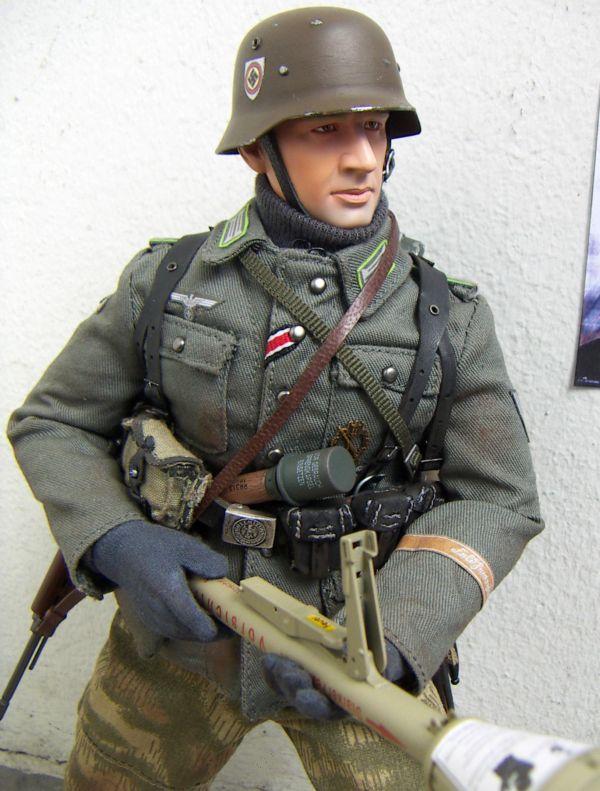
[hr:196243ce96]

[hr:196243ce96]

[hr:196243ce96]

[hr:196243ce96]
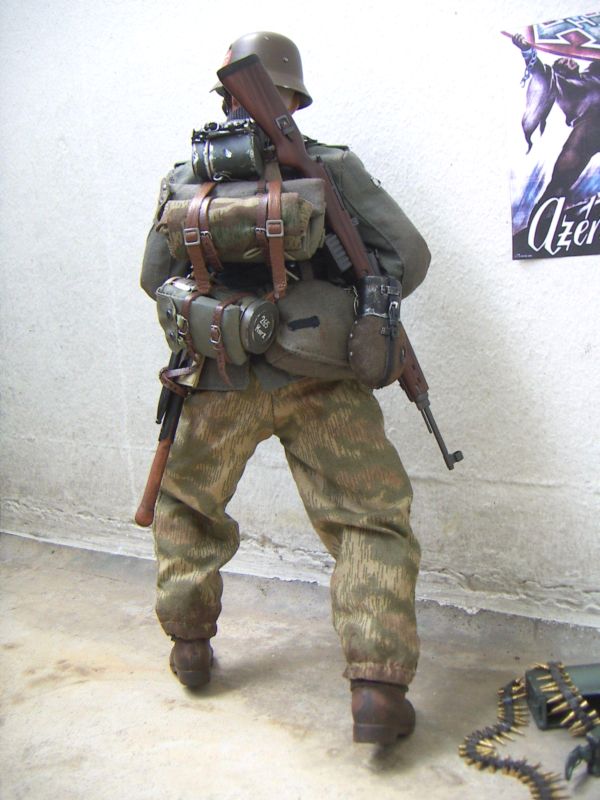
[hr:196243ce96]
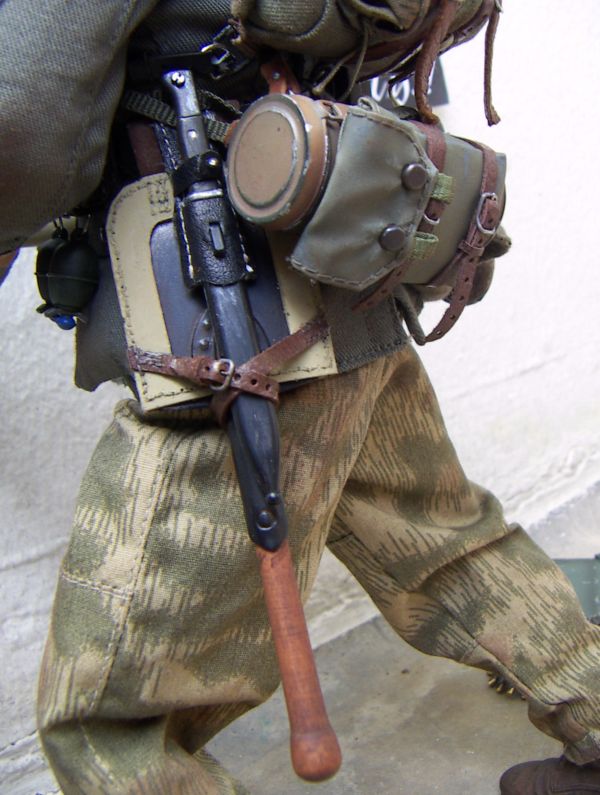
[hr:196243ce96]
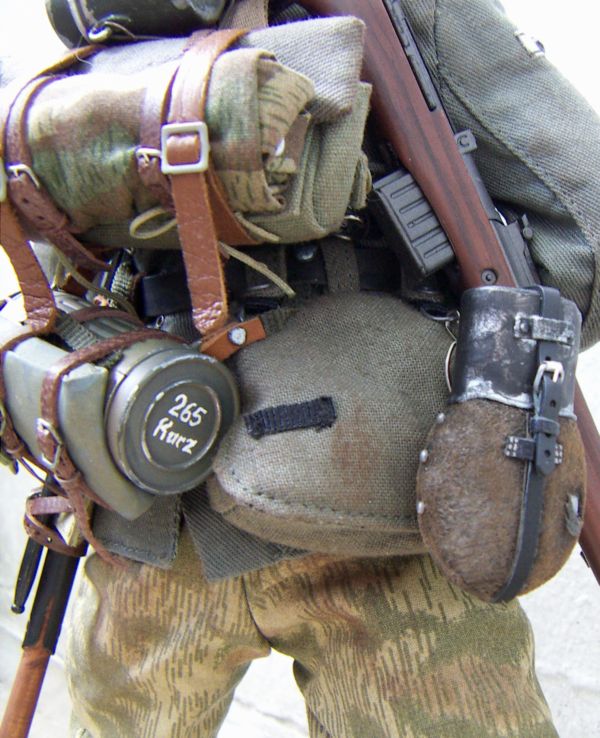
[hr:196243ce96]

An original photo from Budapest, 1945, showing a soldier from “Feldherrnhalle” in front of a King Tiger from sPzAbt 503. The helmet decal is just visible.
[hr:196243ce96]
The “Feldherrnhalle” units were combat formations which drew manpower from the SA, tracing their history back to the 1923 Beer Hall Putsch. The Feldherrnhalle (“Hall of Generals”) is the monument in Munich where the coup was crushed, and the units which bore the title were considered the elite of the SA. The original “Feldherrnhalle” regiment wasn’t a combat unit, but provided guard units for SA offices. The “Feldherrnhalle” units fought with distinction from 1940 to 1945 and were considered elite formations, yet they are almost forgotten.
In March 1938, men from the regiment were among the first units to march into Austria during the Anschluss. In September 1938, the “Feldherrnhalle” regiment was placed under the control of the Wehrmacht, and part of the regiment was used to form the 271.Infanterie-Regiment of the 93.Infanterie-Division. The 271st fought well in France in 1940, and went on to participate in Operation Barbarossa, fighting with distinction on the Leningrad front. In the summer of 1943, the regiment was sent to France, where it was rejoined by her sister regiment (120.IR) after being apart for five years. They were amalgamated into the new 60.Panzergrenadier-Division “Feldherrnhalle”, and returned to the Eastern Front in December, 1943, where it was involved in the fighting withdrawal in Byelorussia. It was transferred to the Narva bridgehead, where it saw heavy action until ordered south to Army Group Centre. The division was annihilated outside Minsk in late July during Operation Bagration. Members of the division who had been absent were ordered to reform in Germany during the fall of 1944, forming the Panzergrenadier-Division “Feldherrnhalle”. It was promptly sent to Hungary to help shore up the front, and contributed in halting the Soviet advance on Budapest. This just delayed the inevitable, and in February 1945, “Feldherrnhalle” was destroyed again together with other German units when Budapest fell. Among those to escape the pocket was a group of several hundred “Feldherrnhalle” men.
The surviving veterans formed the cadre for Panzer-Division “Feldherrnhalle 1”, and fresh SA recruits filled the ranks. The new division became part of Panzerkorps “Feldherrnhalle”. The corps was activated at the end of February, with most of the combat units being sent into action at the end of March 1945. The Panzerkorps executed a fighting withdrawal towards Vienna and then into southern Austria. Over the last months of the war, the corps saw heavy fighting and acquitted itself well. By the beginning of May 1945, the shattered remnants of the corps broke up and attempted to reach the American lines, where they surrendered on 9 May 1945. The majority of the survivors ended up in Soviet PoW camps.
My interpretation of a “Feldherrnhalle” Panzergrenadier is based on a combination of common German army uniform items and gear together with unit-specific insignia, intended to create the impression of one of those who was fortunate enough to be at home, recuperating from wounds sustained at Narva, thereby avoiding the catastrophe outside Minsk in 1944. His gear and uniform is a mix of new, old and re-issued stuff. A survivor of Budapest, Kurz is determined to do what he can to stop the Red Army steamroller. He’ll need all the luck he can get…
Figure: DML Erhard Kurz
The figure is unmodified, apart from being fitted with bendy hands.
Uniform: DML Soldat 004B
Camo trousers: DML Jupp Bauer
Sweater: DML
Gloves: DiD
Boots: DML
The uniform and associated items are slightly weathered with dark brown pastels, and in the case of the boots acrylics as well.
Medals: DML, DiD
Kurz carries the bronze Infantry Assault Badge, awarded back when his unit was motorized infantry. The black Wound Badge isn’t visible, but shows that he has sustained a couple of wounds serious enough to qualify for the award. The tank destruction badge is the tank from a DiD badge, painted and mounted on silver-grey trim.
Helmet: DiD
The DiD Waffen-SS helmet was repainted dark brown and custom decals were applied. Surviving “Feldherrnhalle” helmets are usually dark brown and with double decals. About ten genuine double decal combat helmets are preserved. The decals were varnished to give them a slight sheen. A custom chinstrap was fitted.
Insignia: DML, CVI, custom
The shoulderboards are standard DML items, customized with “embroidered” SA Kampfrunes printed in Panzergrenadier green. The collar tabs, national eagle and Obergefreiter chevrons are from CVI. The cuff title was printed on paper and clued to thin, white trim for increased durability. All custom insignia and decals were created from photos and scans, cleaned up with MS Paint, and printed on an inkjet printer.
Belt, Y-straps: DiD
The (p)leather was given a thin coat with diluted black acrylic paint and were slightly weathered.
G43 magazine pouch: DML
Ammo pouch: Newline Miniatures
The ammo pouch had a spanking new shiny black leather look, white seams and natural leather edges, all of which were fixed with very dark black-brown acrylic paint.
E-tool: DiD
E-tool carrier: custom
The wood and metal entrenching tool needed a carrier that looked late war. A typical carrier was made from “Press-stoff” cardboard-and-resin ersatz leather, but the plastic version from DML looked too clunky. I made one from scratch, using thin cardboard which was sewn by hand, fitted with leather straps, and painted with acrylics.
Canteen: DML
Painted, dented and torn to give it a used look, and fitted with a custom strap and buckle.
Breadbag: DML
Standard M44 breadbag with the shiny D-rings replaced, and weathered with pastels.
Mess kit: DML
Painted and dented to give it a used look, and fitted with a custom strap and buckle. The shiny steel carrying handle was replaced with one made from darker steel wire.
A-frame & bag: DML
The snaps on the bag were removed, and the pleather A-frame straps replaced with real leather straps and BBi buckles.
Zeltbahn roll: custom
A roll made from DML splinter pattern material, with a couple of spare buttons added. Custom straps.
Zeltbahn pole bag: DML
Gas mask container: BBi
Gas cape pouch: DiD
The gas mask container was fitted with proper strap ends, weighted with lead shot, and slightly weathered. The headsculpt number and name of the figure was added in white acrylics, making it look like the markings common on period containers. The gas mask pouch was slightly weathered and strapped to the container with two custom straps.
G43: DML
A real leather sling was fitted on the Gewehr 43. The plastic fake strap end on the stock was trimmed and painted.
Bayonet: HumanWave Figures
The grip got a repaint, and the leather frog was shortened to correct length. The strap stud was replaced with one that was less bulky, and the strap shortened to tighten up the slack.
Grenades: DML
The M24 stick grenade handle has got a brown wash.
Panzerfaust: Twisting Toyz
Props: DML, DiD
DML ammo box, DiD ammo belt. The period “Azertis” Hungarian Arrow Cross fascist propaganda poster was found on the Internet.
[hr:196243ce96]
[hr:196243ce96]
[hr:196243ce96]
[hr:196243ce96]
[hr:196243ce96]
[hr:196243ce96]
[hr:196243ce96]
[hr:196243ce96]
[hr:196243ce96]

An original photo from Budapest, 1945, showing a soldier from “Feldherrnhalle” in front of a King Tiger from sPzAbt 503. The helmet decal is just visible.
[hr:196243ce96]
